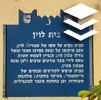
The ultimate street signs, historical sites and house numbers
 Click for a larger image
Click for a larger image  Click for all signs belonging to Heritage Sites in Israel
Click for all signs belonging to Heritage Sites in Israel
 The closest sign from this series (60 Meter): Holon - Heritage Sites in Israel - Local Council House
The closest sign from this series (60 Meter): Holon - Heritage Sites in Israel - Local Council House 
 143 Meter |
143 Meter |  145 Meter |
145 Meter |  189 Meter |
189 Meter |  254 Meter |
254 Meter |  262 Meter
262 Meter